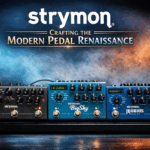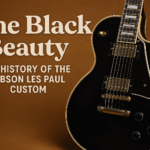Gibson guitars have been an enduring icon in music since their inception, influencing artists across genres from jazz and blues to rock and pop. From humble beginnings to the creation of some of the most revered models in guitar history, Gibson’s journey offers a fascinating look into the evolution of the electric and acoustic guitar. This blog post will walk you through each key model, from Gibson’s founding in 1902 to its modern catalog.
1900s-1920s: The Birth of Gibson
1902: Gibson Mandolins and the Company’s Start
Gibson was founded by Orville Gibson in Kalamazoo, Michigan, focusing initially on mandolins. Orville Gibson’s innovative carved-top designs in mandolins established a high-quality standard, helping the brand gain recognition quickly.
1922: L-5 Archtop Guitar
The L-5, introduced in 1922, was a revolutionary archtop guitar designed by Lloyd Loar. With its f-holes, carved top, and beautiful craftsmanship, it became the first of its kind and set the stage for Gibson’s entry into the jazz market. The L-5 remains a classic and one of the most celebrated archtops ever produced.
1930s: Expanding into Flattop Acoustics
1934: Jumbo and J-35
In the 1930s, Gibson ventured into flattop acoustics, responding to the demands of folk and country musicians. The Jumbo, and later the J-35, were among Gibson’s first large-bodied acoustics, aimed at competing with Martin’s dreadnoughts.
1936: Gibson ES-150
The Gibson ES-150 was introduced in 1936 as the first commercially successful electric guitar, largely due to its “Charlie Christian” pickup. The ES-150 was a crucial model in jazz and helped push guitar from a rhythm to a lead instrument.
1940s: War-Era Models and Early Innovations
1942: The J-45
The J-45, known as “The Workhorse,” debuted during WWII. It featured a more affordable build than Gibson’s earlier models and became a staple for folk, blues, and rock musicians. The J-45’s rich tone and robust build have made it one of Gibson’s longest-lasting models.
1949: Gibson ES-5
The ES-5 was Gibson’s first model with three pickups, introduced in 1949. Designed for versatility, it allowed players to blend different pickup combinations, setting the stage for the electric guitar’s tonal diversity.
1950s: The Golden Age of Gibson Models
1952: Les Paul Standard
The iconic Les Paul Standard was introduced in 1952 after a partnership with guitarist Les Paul. The Les Paul featured a solid mahogany body, carved maple top, and P-90 pickups, marking Gibson’s serious entry into solid-body electrics. Later iterations like the 1958-1960 Les Paul Standard with humbucking pickups became some of the most sought-after guitars in history.
1955: Les Paul Custom, Junior, and Special
Gibson expanded the Les Paul line with several variations:
• Les Paul Custom (1955): Also known as the “Black Beauty,” with an ebony finish and additional aesthetic features.
• Les Paul Junior (1954): A more affordable, single-pickup model targeting beginner guitarists.
• Les Paul Special (1955): Similar to the Junior but with two pickups, offering a richer tonal range.
1958: The Flying V and Explorer
In 1958, Gibson introduced the futuristic-looking Flying V and Explorer models. Initially commercial failures, these guitars eventually found favor among rock and metal players for their unique shapes and powerful sounds, becoming symbols of rebellion and innovation.
1960s: Shifting Trends and the Rise of the SG
1961: The SG Model
In 1961, Gibson rebranded the Les Paul with a thinner, double-cutaway body and renamed it the SG (Solid Guitar). With improved upper fret access, the SG became a favorite for rock players, finding fans in Angus Young and Tony Iommi. The SG line quickly became one of Gibson’s best-selling and most recognizable models.
1968: Reintroduction of the Les Paul Standard
After a brief discontinuation, the original Les Paul Standard and Custom models were reintroduced in 1968 due to growing demand. They quickly gained a cult following and established Gibson’s position as a leader in electric guitar design.
1970s: Expanding Horizons and the “Norlin” Era
During the 1970s, Gibson was acquired by the Norlin Corporation. Under Norlin, Gibson expanded production and released several unique models, though often with mixed reception.
1973: L-6S
The L-6S was Gibson’s first solid-body guitar with a 24-fret neck. Though never reaching the success of the Les Paul, it was embraced by a few notable musicians like Carlos Santana.
1975: The RD Series
The RD series introduced active electronics and a longer 25.5-inch scale length. The futuristic RD Standard, RD Artist, and RD Custom had mixed success but remain interesting examples of Gibson’s willingness to innovate.
1980s: Return to the Classics
In the 1980s, Gibson began reissuing its classic models to meet the demand for vintage-inspired guitars.
1981: The Heritage Series
The Heritage Series was Gibson’s first reissue line, closely replicating the specs of famous Les Paul Standards from the 1958-1960 period. These guitars helped usher in the vintage craze that’s still alive today.
1986: The ES-335 Dot Reissue
Gibson reissued the ES-335 Dot model to replicate the early versions from the late 1950s, reigniting interest in the semi-hollow body style.
1990s: The Custom Shop Era
1993: Gibson Custom Shop
The Gibson Custom Shop opened in 1993, allowing for meticulous, historically accurate reissues and one-off custom models. This move helped Gibson cater to players seeking high-end, hand-crafted instruments and created a demand for limited-edition reissues.
2000s: Modern Innovations and New Series
2002: Les Paul Classic and Studio Lines Expand
The Les Paul Studio and Classic lines were expanded, offering variations in wood types, finishes, and pickups, catering to players of all levels.
2008: Robot Guitar and Dark Fire
In 2008, Gibson released the self-tuning Robot Guitar, later followed by the Dark Fire model with advanced electronic features. While divisive, these models showcased Gibson’s interest in modern tech.
2010s: The Standard Gets a Makeover
2012: The 100th Anniversary of Les Paul
Gibson introduced several tribute models for the 100th anniversary of Les Paul’s birth. The Les Paul Standard and Traditional models were updated with coil-splitting pickups and slimmer neck profiles, adapting to modern tastes while honoring tradition.
2016: Return of Vintage-Inspired Models
In response to market demand, Gibson reintroduced traditional specs across several models, with a renewed focus on heritage-based design in the Les Paul Standard and SG Standard.
2020s: A Focus on Heritage and Quality
2020: The Original and Modern Collections
Gibson simplified its lineup into the “Original” and “Modern” collections. The Original Collection focused on classic specs, while the Modern Collection included advanced features like weight relief, asymmetrical necks, and push-pull controls for tonal variety.
2021: Gibson Murphy Lab
The Gibson Murphy Lab, a division of the Custom Shop, began producing “aged” guitars, with finishes that replicate vintage wear and tear. These high-end models aim to capture the feel and tone of true vintage guitars.
Conclusion: Gibson’s Legacy Continues
From mandolins to some of the most iconic guitars in history, Gibson’s journey reflects an ongoing pursuit of innovation paired with a deep respect for tradition. Today, Gibson offers models that cater to both purists and modern players, proving that the brand’s legacy remains strong. With each guitar model, Gibson continues to shape the music world, ensuring its guitars will inspire future generations.







